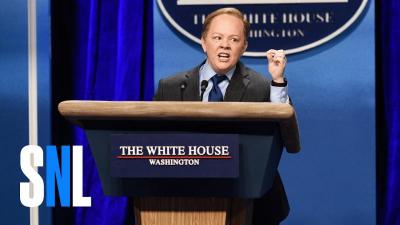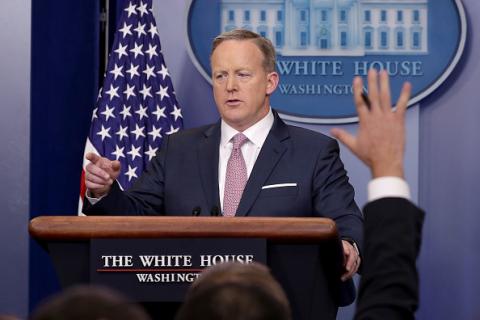Matthew Schaefer
This Past Perfect will also appear in NAR's Summer 2017 issue, which will be available for pre-order here.
It sounds like the set-up for a bad joke: “The President, the Press Secretary and the White House Press Corps walk into a room . . .” It may well be a bad joke, but the punch line remains elusive. Each of the primary agents in this now-daily drama are driven by different agendas and motives. Despite the proclaimed goal of transparency and the presumption that all involved are adults, the White House Daily Briefings often devolve into raucous, even rancorous, behavior more expected on a primary school playground than in a room so proximate to power.
 When did the veneer of civility wear so thin that shouting and rude dismissals became the order of the day? How did a venue and process designed to inform the American public of important issues and policies get reduced to snippy sound bites? Surely White House press conferences were not purposely built for parody. Despite what the late-night comics and weekly satirists would have you believe, more should be expected from these briefings than mere comic relief.
When did the veneer of civility wear so thin that shouting and rude dismissals became the order of the day? How did a venue and process designed to inform the American public of important issues and policies get reduced to snippy sound bites? Surely White House press conferences were not purposely built for parody. Despite what the late-night comics and weekly satirists would have you believe, more should be expected from these briefings than mere comic relief.
Strangely enough, this chaos does not seem to be a recent development. Early in the Hoover Presidency, Ray Tucker lauds Hoover for his innovative approach to the White House Press. Unlike his immediate predecessors, Hoover spoke to the press directly. He spoke plainly, hewing to facts, his intended policies, and the interplay between them. He spoke without recourse to the fictive “White House Spokesman”— when Hoover spoke to the press it was for the record. He laid out his policies and philosophy (often at great length). When he had nothing to say, he’d tell the White House Press Corps in so many words: “I have nothing for you today.”
Hoover’s honeymoon with the press was short-lived. No amount of plain- speaking could obscure the fact that his administration did not have answers to the crisis of the Great Depression. But, for a brief shining period, Tucker and others held Hoover up as a paragon of openness, or what we would label as transparency.
The current administration has not enjoyed a similar honeymoon with the press. I am chary of leaning too heavily on historical comparisons. Too much time has passed, too many factors have changed, and too many variables blur the bright lines of a point-by-point comparison. In Hoover’s time, the press had a collegial, if not congenial, relationship with the President. The press was primarily a print medium. The cutting-edge technology of radio had not yet reached a majority of American homes. The modern President faces a combative press, the demands of a 24-7 news cycle, and the means to reach the public without using “lamestream” media. All face new challenges—multiple points of contact, disparate voices speaking for the Administration, factual and fake news. What is to be done?
We must hold accountable the President, the Press Secretary and the White House Press Corps. If we accept this new normal with a knowing chuckle or derisive laugh, it will continue to be fed to us. We get the governance that we elect. So too, do we get the information, facts, and behavior that we expect. Unpressed, the President, the Press Secretary and the Press Corps will continue this circus. Meanwhile we run the risk of seeing civic engagement become a spectator sport.
Demand accountability. Demand adult behavior. Don’t be gulled by pish-tosh and misdirected laughter. While the White House Press Gaggle (a real thing I assure you) might elicit a giggle, stop and consider the serious business that should be undertaken by these actors in this room.
Ray T. Tucker
White House press relations have been conducted under a one-sided arrange- ment, in which all the rules have been made by and for the President rather than the public . . . . I have spoken of the “rules,” but in actuality there was, until President Hoover took charge, only one rule in this great game of picturing a President and postulating his thoughts for the American people. He was never to be quoted unless, on rare occasions, he gave specific permission.
Behind such conventional phrases as “It is believed” or “The President has told callers”—we shanghaied and hid the President and veiled his words of wisdom.
Ingenuity reached its burlesque climax when somebody—nobody knows who— invented the phrase of “The White House Spokesman.” But that nom de president soon became the butt of vaudeville, editorial and senatorial jibes . . . .
The White House battle cry in this duel [with the press] has been, more often than not, “Give them nothing—or as little as possible . . . .” Both the style and the substance of presidential utterances of an earlier day were so ambiguous, whether deliberately or unconsciously, that it was impossible to present a faithful report to the reading public.
But there is never any doubt of Mr. Hoover’s ideas, attitude or meaning. His mind functions in machinelike manner. He speaks crisply and clearly. He responds to questions designed to clarify or elaborate his statements. More important still, perhaps, he deals in realities. He presents factual reports of what he has done or proposes to do. . . .
This is not to say that the millennium has arrived, but we prefer to conduct our eternal crusade for news under a White House banner bearing the inscription: “Give them facts” instead of the torn and tattered ensign: “Give them nothing.”
From the North American Review, June 1929, Volume 227, Issue 6, pp. 661-669.



